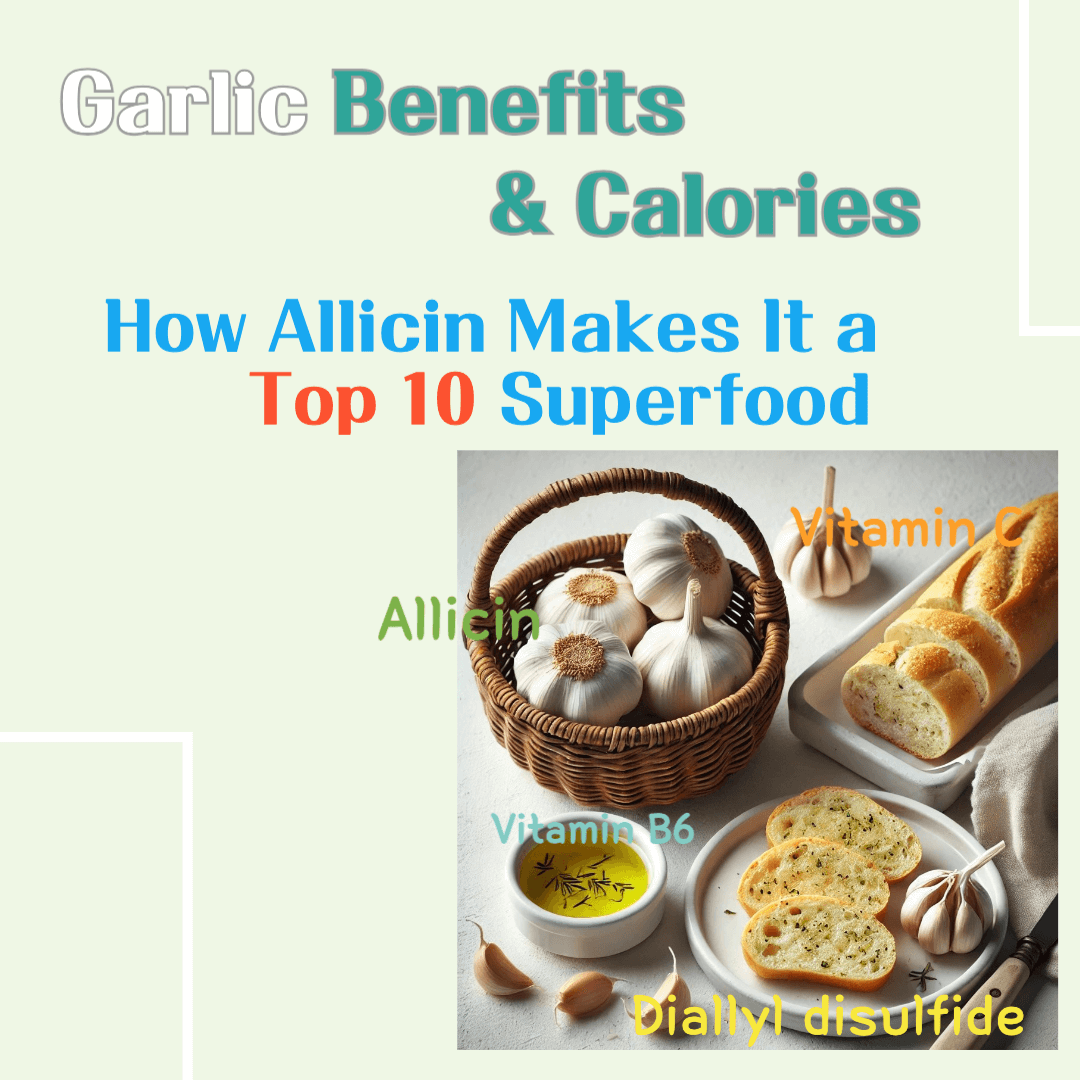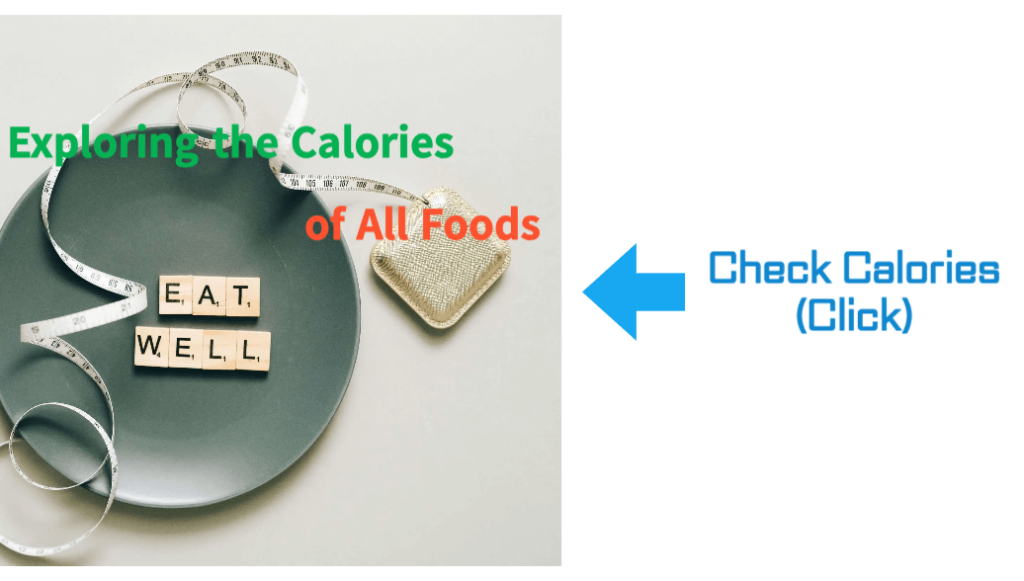Garlic Benefits & Calories: How Allicin Makes It a Top 10 Superfood
Through ‘Garlic Benefits & Calories: How Allicin Makes It a Top 10 Superfood‘ post, we will delve deeply into the benefits, nutritional components, calories, seasonal availability, selection tips, and storage methods of garlic.
To describe garlic in a single sentence:
“The powerful benefits of allicin, garlic as a global top 10 superfood.”
Garlic has been cherished worldwide as one of the top 10 superfoods from ancient times to the present. With its potent health benefits and distinctive flavor, garlic has been widely used in both cooking and medicine. In ancient Egypt, garlic was a staple food provided to pyramid construction workers to aid in fatigue recovery and boost their strength. Similarly, ancient Greek Olympic athletes consumed garlic to enhance their energy and prepare for competitions.
In Korea, garlic has long been used as a traditional medicinal ingredient. The Dongui Bogam(an ancient Korean medical text) highlights garlic as a beneficial remedy for fatigue recovery and improving blood circulation.
Garlic’s most prominent feature and benefits derive from allicin, a sulfur compound. Allicin is the key to garlic’s incredible health properties, and exploring these benefits through this post will be enlightening.
We’ve organized garlic’s benefits, nutritional components, seasonal details, and selection tips into easy-to-understand visuals and tables for a clear overview.
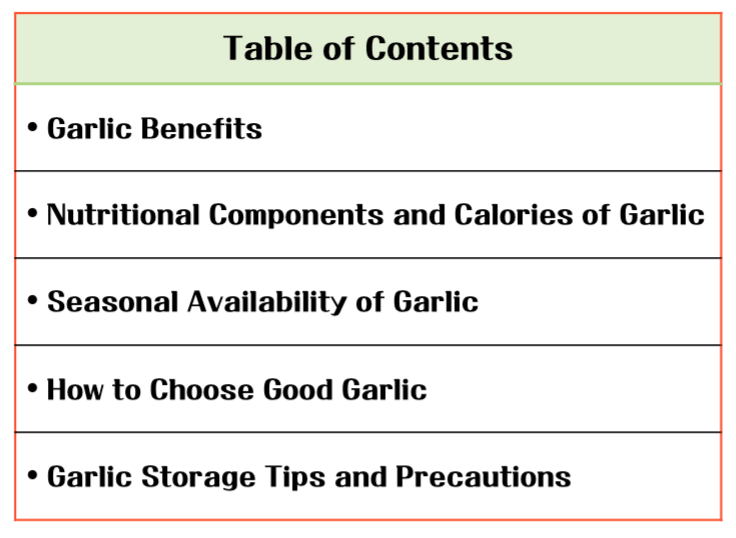
Let’s dive in and explore these topics together.
- Garlic Benefits
1. Anti-Inflammatory Properties
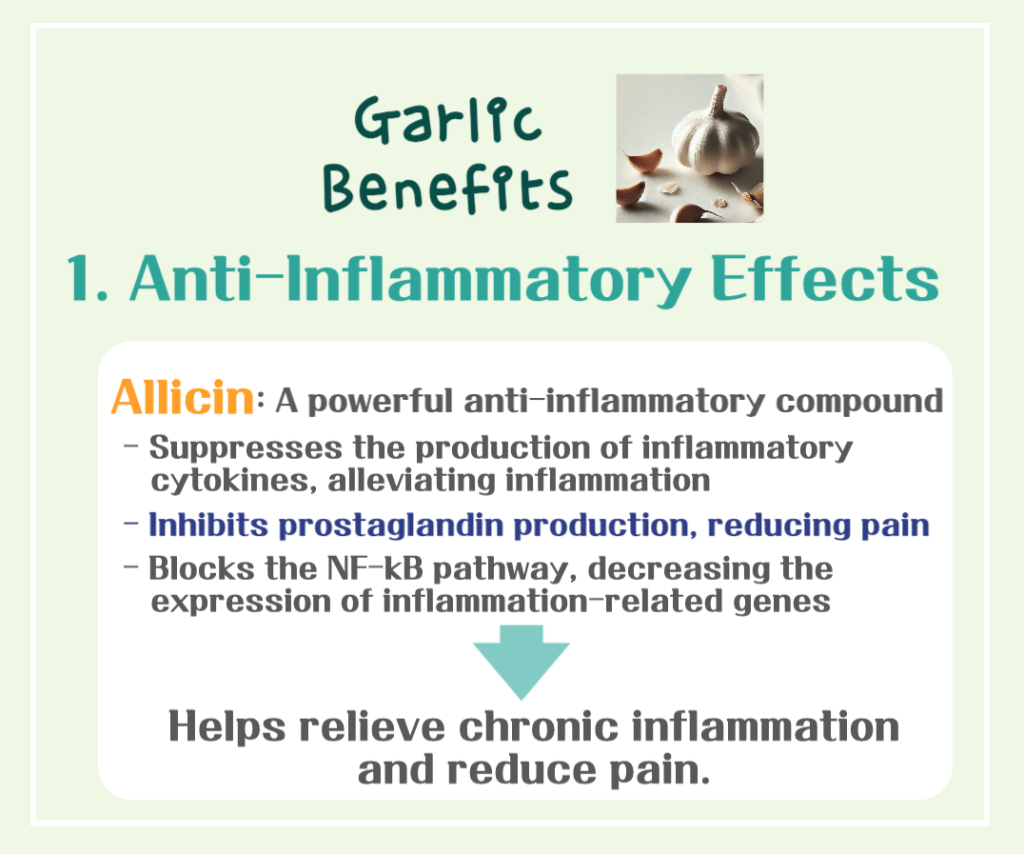
* The allicin compound found abundantly in garlic acts as a powerful anti-inflammatory agent. It suppresses the production of inflammatory cytokines and prostaglandins, which are mediators of inflammation, thereby helping to reduce inflammation and pain.
※ Allicin: A potent anti-inflammatory agent responsible for garlic’s distinct smell and pharmacological effects.
– Inhibits the production of cytokines that trigger inflammatory responses, preventing tissue damage caused by inflammation.
– Suppresses the generation of prostaglandins, inflammatory mediators that cause pain and swelling at inflamed sites, reducing pain and edema.
– Blocks the NF-κB signaling pathway, a key inflammatory signaling pathway, decreasing the expression of inflammation-inducing genes.
2. Cardiovascular Health Improvement
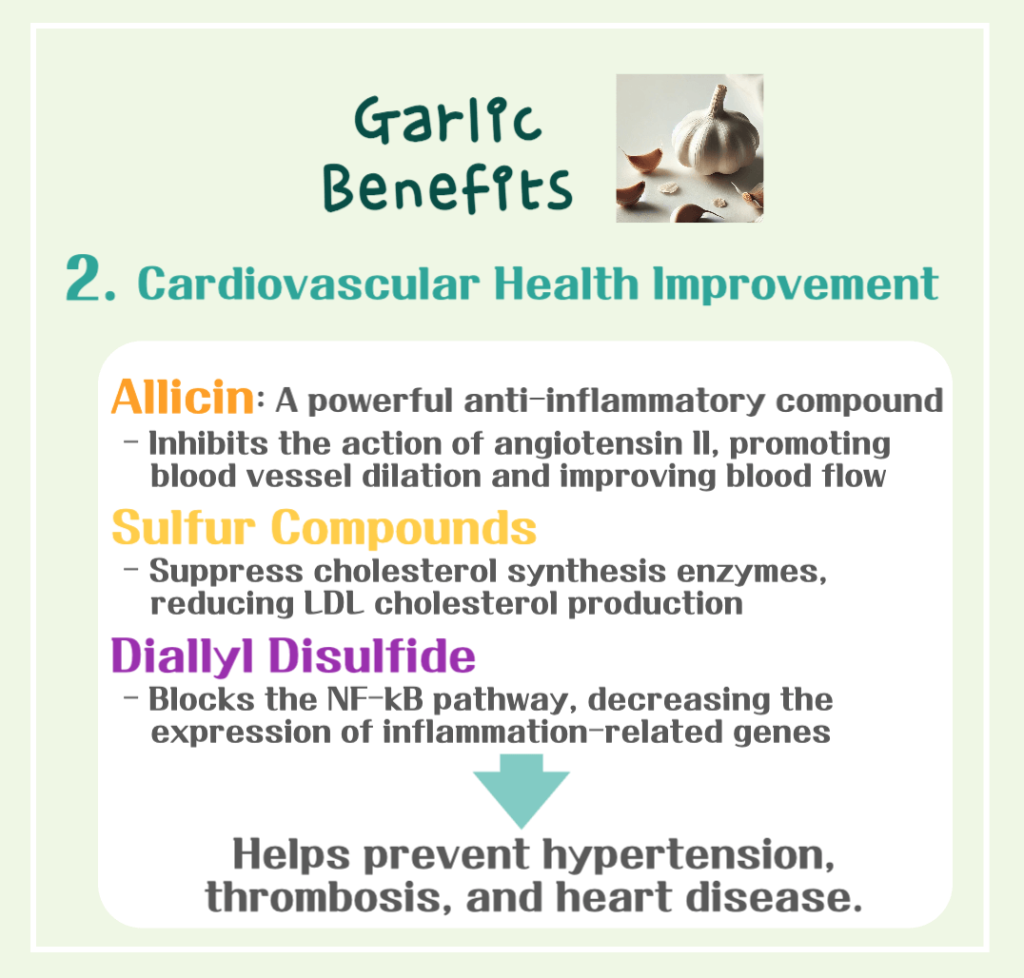
* The abundant sulfur compounds in garlic help relax blood vessels, facilitate blood flow, lower LDL cholesterol levels, and inhibit blood clot formation. These actions contribute to preventing heart disease and promoting overall cardiovascular health.
※ Sulfur Compounds: Includes allicin, diallyl disulfide, diallyl trisulfide, and ajoene.
– Inhibits the activity of cholesterol synthesis enzymes in the liver, reducing LDL cholesterol synthesis while increasing HDL cholesterol levels.
※ Allicin
– Suppresses the action of angiotensin II, an enzyme that constricts blood vessels, leading to vasodilation, improved blood flow, and reduced blood pressure.
※ Diallyl Disulfide
– Blocks the blood clot formation pathway by inhibiting platelet aggregation, preventing thrombus formation and reducing the risk of myocardial infarction and stroke.
3. Immune System Boost
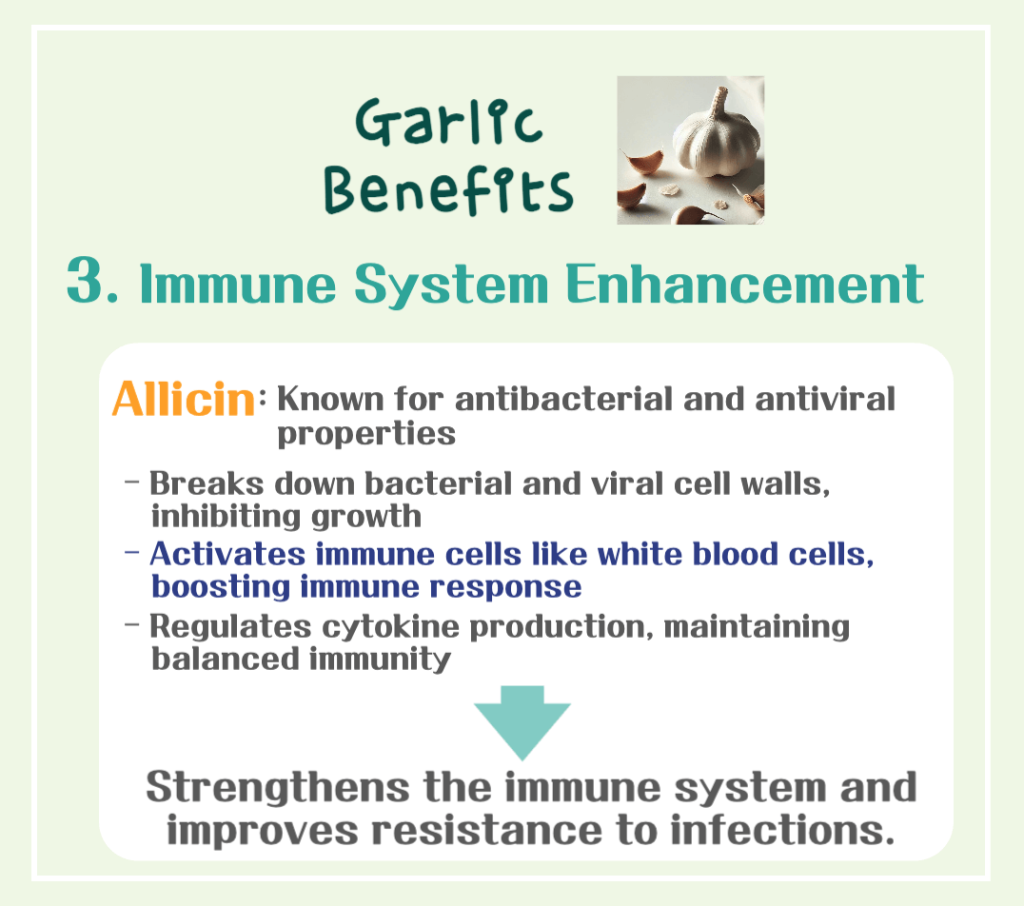
* The abundant allicin in garlic activates and strengthens the immune system through its antibacterial and antiviral effects, enhancing the body’s ability to fight infections. This helps protect against pathogens such as bacteria, viruses, and fungi, aiding in the prevention of infectious diseases.
※ Allicin: Known for its antibacterial and antiviral effects.
– Potent Antimicrobial Action: Disrupts bacterial cell walls and inhibits enzymatic functions, suppressing the growth of pathogens.
– Immune Cell Activation: Stimulates the production and activation of immune cells, such as white blood cells (T-cells and NK cells), enhancing immune responses to external pathogens.
– Reduction of Inflammatory Cytokines: Inhibits the secretion of inflammatory cytokines like interleukin-6 (IL-6), preventing tissue damage caused by excessive inflammation.
– Protection Against Viral Infections: Blocks the viral cell invasion process and inhibits viral replication, helping prevent viral infections, including colds, flu, and coronaviruses.
4. Joint Health Protection

* The abundant allicin in garlic helps reduce joint inflammation and pain through its anti-inflammatory and antioxidant properties, aiding in the prevention and management of chronic joint conditions like arthritis. Additionally, diallyl trisulfide protects against cartilage damage and promotes cartilage cell regeneration, supporting joint function and health.
※ Allicin: Known for its anti-inflammatory and antioxidant effects.
– Inhibition of Cytokine Production: Suppresses the generation of inflammatory mediators, reducing inflammation within the joints.
– Neutralization of Reactive Oxygen Species (ROS): Decreases oxidative stress in joints, preventing damage to cartilage and joint cells and slowing cartilage degeneration.
※ Diallyl Trisulfide
– Inhibits cartilage destruction and promotes the regeneration of cartilage cells, supporting the maintenance of joint integrity and function.
5. Anticancer Effects

* The abundant sulfur compounds in garlic contribute to reducing the risk of cancer by inhibiting the proliferation and metastasis of cancer cells through various mechanisms.
※ Sulfur Compounds: Includes allicin, diallyl disulfide, diallyl trisulfide, and ajoene.
– Detoxification and Neutralization of Carcinogens:Activates liver detoxification enzymes to eliminate carcinogens from the body.
– Induction of Apoptosis:Promotes the expression of genes that induce apoptosis (programmed cell death) in cancer cells, restricting their growth.
– Inhibition of Growth and Proliferation:Blocks the production of essential proteins or enzymes required for DNA replication, effectively suppressing cancer cell proliferation.
– Anti-Angiogenesis:Prevents the formation of new blood vessels by cancer cells, cutting off their supply of nutrients and oxygen, thereby inhibiting tumor growth.
6. Additional Benefits
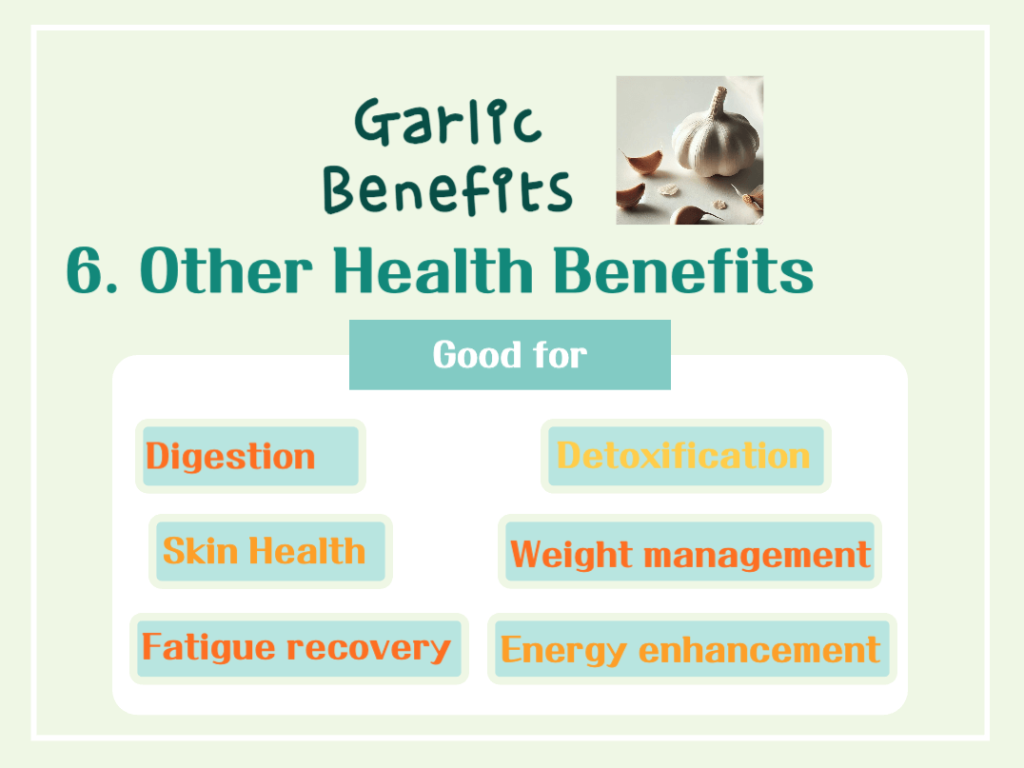
* Also beneficial for the following conditions:digestion improvement, detoxification, weight management, fatigue recovery, skin health, energy enhancement, respiratory health, and more.
※ Digestion Improvement: The prebiotics in garlic promote the growth of beneficial gut bacteria while inhibiting harmful bacteria, helping to prevent digestive issues and intestinal disorders.
※ Detoxification: Garlic’s sulfur compounds stimulate the production and activity of glutathione (GSH) in the liver, neutralizing toxins and aiding in their elimination from the body.
※ Weight Management and Fat Breakdown: Garlic enhances fat metabolism and increases the activity of lipase enzymes, preventing fat accumulation in the body.
※ Fatigue Recovery and Energy Enhancement: Adenosine in garlic promotes blood circulation, ensuring efficient delivery of oxygen and nutrients to cells. Additionally, B vitamins and selenium boost metabolism, enhancing energy levels.
※ Skin Health: The abundant allicin in garlic, with its anti-inflammatory properties, helps reduce skin inflammation caused by conditions such as acne or eczema.
※ Respiratory Health: Garlic’s allicin reduces inflammation in the respiratory mucosa and decreases mucus production, enabling smoother breathing.
- Garlic Nutritional Components and Calories
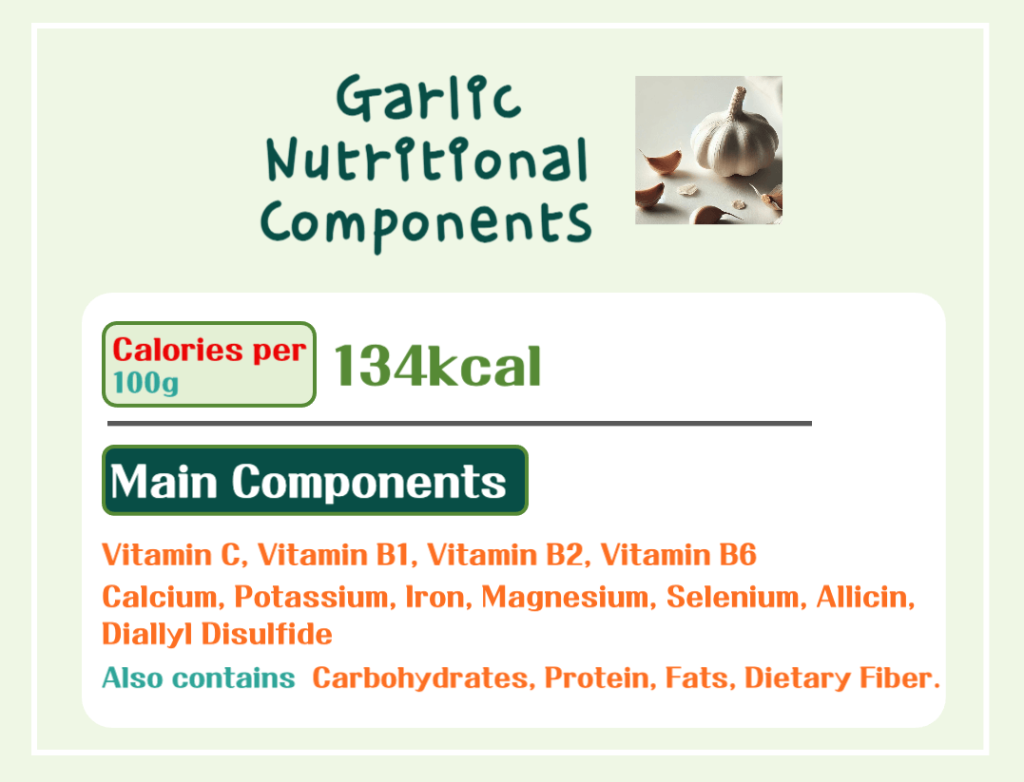
* The calorie content of garlic is 134 kcal per 100g.
* Garlic is a low-calorie, low-fat food rich in sulfur compounds like allicin, as well as vitamins and minerals, making it an exceptionally healthy food and one of the world’s top 10 superfoods.
- Seasonal Availability of Garlic

* Peak Season: Garlic is in season from May to July.
* Characteristics by Season
– Spring (May–June): Fresh garlic, known for its highest freshness, abundant moisture, and milder spiciness. Rich in anti-inflammatory and antioxidant compounds.
– Summer (June–July): Stronger aroma and spiciness. Fully matured with hardened skins, making it highly durable and suitable for long-term storage.
- How to Choose Garlic
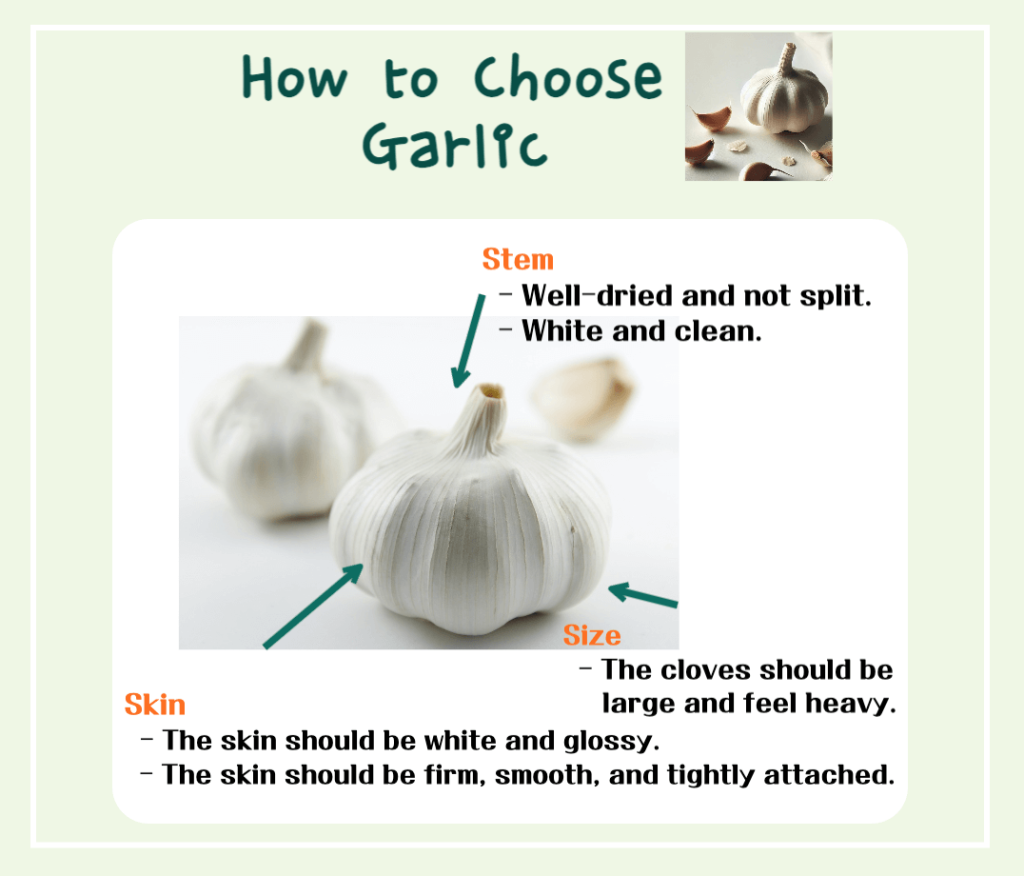
* Skin:Look for garlic with firm, smooth, tightly attached skin that is white and glossy.
* Size:Larger and firmer cloves are of better quality. The garlic should feel heavy when held.
* Stem:The stem should be clean, firm, and well-dried without any splitting.
- Garlic Storage Tips and Precautions
1. Storage Tips
– Store in a dry and cool place: Ideally at a temperature of about 10–15°C.
– Ensure good ventilation: Keep garlic in breathable mesh bags or baskets to allow air circulation.
– Separate sprouted garlic from healthy garlic: Prevent the spread of spoilage.
– Freeze minced garlic for long-term storage: Peel and mince the garlic before freezing.
– Store in oil (minced garlic): Submerge minced garlic completely in olive or vegetable oil and refrigerate.
2. Precautions
– Avoid humid environments: Moisture can cause mold growth or sprouting.
– Do not store in the refrigerator: The high humidity in refrigerators can cause garlic to become damp and sprout.
Through ‘Garlic Benefits & Calories: How Allicin Makes It a Top 10 Superfood‘ post, we explored everything about garlic, from its benefits, nutritional components, and calories to its seasonal availability, how to choose the best garlic, and proper storage methods. We hope this post has provided you with a deeper understanding of garlic.
Below, we recommend additional posts you might find interesting.
It would be great to also check the calorie information for various foods.
Thank you for taking the time to read through this lengthy post.
